Jun 9, 2022
In years past, as the weather warmed up, the staff and alumni looked forward to renewing old acquaintances and socializing with colleagues from across the hospital’s departments. This blog post will highlight the three main traditions of spring, mention their roots and how they evolved.
The first event was the annual alumni dinner, which gathered all the graduates of the Resident training program together to enjoy a good meal, good conversation, and informative lectures. The Society of the Alumni of St. Luke’s Hospital of New York City was established in 1891 and was formed with the intent to “foster collegiality and scientific discourse and to honor accomplished colleagues at an annual dinner.”
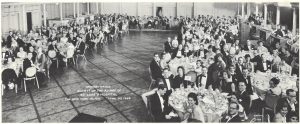
The image above, taken from the News of St. Luke’s newsletter, depicts the dinner held on April 30, 1965, at the New York Hilton Hotel.

This photo memorializes the St. Luke’s 1973 alumni dinner at the 7th Regiment Armory.
In 1896, Roosevelt Hospital ‘ex-interns’ met at the hospital to plan the twenty-fifth anniversary of its opening and organize The Roosevelt Hospital Alumni Association. Its stated purpose was “…maintaining loyalty to the institution and promoting its broader usefulness.” Unfortunately, the Archives does not have any photos documenting their celebrations over the years.
Every June during the 1960s, St. Luke’s Attendings invited the Residents to join them for a “Field Day.” Held at New Jersey’s Englewood Country Club, the usual barriers of position, age, and authority were ignored during an afternoon of hotly contested athletic events (softball, golf, and tennis, swimming, etc.), followed by a casual dinner and evening entertainment.
Evening offerings were often films created by actor/director wannabes, Drs. Harry Roselle and Theodore Robbins and the various colleagues they could round up to help. One year’s offering was a Dr- Kildare-meets-Dracula-at-St.-Luke’s horror flick titled, “Anemia of Uncertain Origin.” Another was a spy thriller á la a 1960s TV comedy favorite titled ‘Get Smart,’ called “Aardvark,” in which Secret Agent 95.6, battled Aardvark, a Fu Manchu-type enemy who developed an infamous blood sludging device.
Each year’s outing was documented with a panoramic photograph of attendees. These photos, usually between four and six feet long and about ten inches high, have proven to be a challenge to store in the Archives. About ten of them arrived, each individually tightly rolled. They required re-humidifying in a makeshift humidification tank in order to relax the paper enough to allow them to be flattened for storage. They are available for viewing for those who wish to walk down memory lane.
In case you, dear reader, are curious, the Field Day photo was cut in two in order to be printed in the former newsletter, The News of St. Luke’s. The images used here were scanned from the newsletter because the originals are too large to fit on current in-house scanners. It may also be of interest to note that the dinner photographs, whose originals are two to three feet long and eight to ten inches high, were taken with a fish-eye camera, which has curved lenses to allow the whole room to fit into one image. The author is not sure what equipment was used to capture the huge Field Day images.


Unfortunately, one year in the early 1970s the event was cancelled due to unforeseen circumstances, and it was not picked up again in the following years.
The final big spring event for many years was the St. Luke’s Hospital School of Nursing graduation ceremonies held at the Cathedral of St. John the Divine, just south of the Hospital. Nursing students would line up at the Hospital and proceed down Amsterdam Avenue, marching up the front steps to enter the Cathedral and take seats at the front while their families observed the ceremonies from behind them. At the end of the ceremonies the graduating class would pose for a group photo on the Cathedral steps.


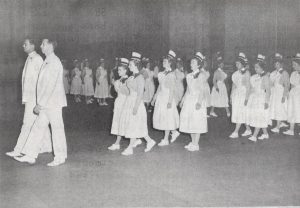

The above images, taken from the News of St. Luke’s newsletter, are of the graduating class of 1955; the image below shows the graduating class of 1974, the year the St. Luke’s Hospital School of Nursing program closed its doors and merged with the Columbia University School of Nursing Bachelor of Science program.

Roosevelt Hospital also had a School of Nursing, founded in 1896. At first, students were accepted on a rolling admission any time, and as students successfully completed the required coursework, diplomas, graduate caps and pins were awarded with little fanfare in the Administration Building. By the 1920s a formal cycle of classes developed, and graduation was set at a fixed time of year. At first, ceremonies were held in the Syms Operating Room, and later, as the number of students grew, the ceremony was moved to a hotel ballroom. Unfortunately, the Archives does not have images from the Roosevelt Hospital School of Nursing graduations, and like St. Luke’s, the hospital-based school also closed its doors in 1974, but the Alumni Association is still fairly active and enthusiastic about staying connected.
Michala Biondi for the Aufses Archives.
May 16, 2022
A history of the ambulance service at Roosevelt Hospital, today’s Mount Sinai West, is available here. See the Building Beth Israel series for more information about the history of Mount Sinai Beth Israel. An interactive map of Beth Israel historical locations is available here.
National EMS Week is May 15-21. In this blog post, we’re celebrating by looking back at a brief history of emergency medical services at Mount Sinai Beth Israel.
The first ambulance service began at Beth Israel Hospital in 1906. It first used a horse-drawn carriage, later switching to automobiles in 1915. During this early period, ambulances were manned by members of the house staff, including Nettie Shapiro, MD, the first female house staff at MSBI in 1909.
By 1984, Beth Israel was “the first voluntary hospital in New York City to have attending physicians fully trained in emergency service on duty around the clock, every day of the week.” New York City did not mandate such 24-hour care in EMS participant hospitals until June 1, 1987.
In 1990, the Division of Emergency Medical Services was named for David B. Kriser, a Beth Israel trustee, in honor of a $3 million bequest from him. This led to a major renovation, and the division doubled in size.
Sources:
Authored by Stefana Breitwieser with research credit to Nicholas Webb
Oct 25, 2021
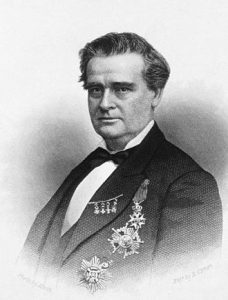 The Woman’s Hospital, often considered the first hospital in this country dedicated to treating the diseases of women, opened on May 4, 1855 in a house on Madison Avenue. It was founded by the currently controversial J. Marion Sims, MD, pictured right, in concert with a group of influential New York City women. Sims arrived in New York in 1853 from his home in Alabama, where he developed a procedure to close vesicovaginal fistulas. He relocated to New York in hopes of improving his own chronic health condition.
The Woman’s Hospital, often considered the first hospital in this country dedicated to treating the diseases of women, opened on May 4, 1855 in a house on Madison Avenue. It was founded by the currently controversial J. Marion Sims, MD, pictured right, in concert with a group of influential New York City women. Sims arrived in New York in 1853 from his home in Alabama, where he developed a procedure to close vesicovaginal fistulas. He relocated to New York in hopes of improving his own chronic health condition.
At first, Sims was welcomed into the medical community of New York and invited to demonstrate his fistula procedure. Unfortunately, once local doctors learned the procedure, they lost interest in him. Sims was unable to establish a strong practice or find a hospital that would offer him operating privileges.
The wife of one of Sims’ few medical friends in the city offered to gather a group of interested and influential women to discuss the state of women’s health care in the city. Thirty-Five women met on February 6, 1855, the outcome of which was the establishment of the Woman’s Hospital Association. The group would move to establish and direct a hospital devoted to the reception and cure of women suffering from “diseases peculiar to their sex.” The Association set up a Board of Managers, referred to as the ‘Board of Lady Managers,’ comprised of thirty-five women, to guide the Hospital. An Executive Committee of seven women, appointed by the Board of Managers, managed the day-to-day affairs of the institution.
In 1857 the Hospital was re-incorporated by the New York State Legislature as the Woman’s Hospital in the State of New York, and re-organized under an all-male Board of Governors. The twenty-seven Governors were responsible for the overall concerns of the Hospital, including filling vacancies of non-female staff, enacting the By-Laws and organizing the Medical Department. Women, however, were still very much in charge of running the Hospital. The former Board of Lady Managers became the Board of Lady Supervisors, and managed the operations of the Hospital, including the appointment of nurses and other female attendants. A smaller Board of Lady Managers remained responsible for handling the day-to-day business of the Hospital. By 1887, the Board of Governors invited four women from the Board of Lady Supervisors to join them. They found this integration “to be most acceptable in its results,” and soon after the Board of Governors was reorganized and evenly divided between men and women.
 As mentioned above, the first Woman’s Hospital was a rented four-story brownstone at 83 Madison Avenue, off 29th Street, pictured left. The brownstone held forty beds and welcomed its first patient in May of 1855. The response to the Hospital’s opening was so great, by fall of 1855 that another surgeon, Thomas Addis Emmet, joined Dr. Sims as the second surgeon on staff. It wasn’t long before the Woman’s Hospital Board was seeking larger accommodations to meet patient demand.
As mentioned above, the first Woman’s Hospital was a rented four-story brownstone at 83 Madison Avenue, off 29th Street, pictured left. The brownstone held forty beds and welcomed its first patient in May of 1855. The response to the Hospital’s opening was so great, by fall of 1855 that another surgeon, Thomas Addis Emmet, joined Dr. Sims as the second surgeon on staff. It wasn’t long before the Woman’s Hospital Board was seeking larger accommodations to meet patient demand.
In 1858, approving the petition of Dr. Sims, the City of New York offered the entire block bounded by 49th and 50th Streets between Lexington and Park Avenues as a site for a new, larger hospital. Originally a Potter’s Field, or Stranger’s Burial Place, the plot was filled with coffins; more than 35,000 of them had to be removed. The first building, the Wetmore Pavilion, opened in 1867 and held seventy-five beds. A matching building, the Baldwin Pavilion, added in 1877, doubled that number. A Mr. Baldwin, who wished to remain anonymous, funded the construction of the second pavilion, contributing $84,000, provided the Association raised the balance of $50,000 to complete it.
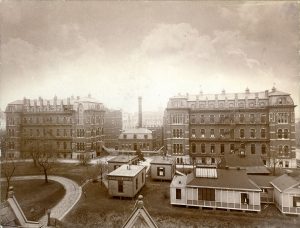 Over the years, the Board recognized the need to develop additional services. A post-graduate school of nursing admitted its first class in 1888. The establishment of a hospital pharmacy in 1881, a maternity ward in 1910, and a social services department in 1912 are examples of the additional services made available at Woman’s Hospital.
Over the years, the Board recognized the need to develop additional services. A post-graduate school of nursing admitted its first class in 1888. The establishment of a hospital pharmacy in 1881, a maternity ward in 1910, and a social services department in 1912 are examples of the additional services made available at Woman’s Hospital.
The 49th Street location proved to be an unsatisfactory one, as the ground tended to be wet, and the basement and ground floors had leaks and dampness. In 1902, all hospital services, except the Out-Patient Clinic, were suspended and the facility was sold. (On a side note, the Waldorf-Astoria Hotel opened on this same plot in 1931.)
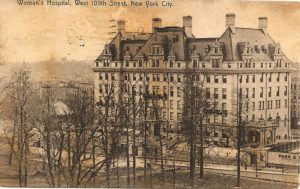 Hospital services resumed in 1906, when a newly constructed Woman’s Hospital opened on West 109th Street, between Amsterdam and Columbus Avenues, pictured left. The hospital functioned here until 1965, when it moved just a few blocks north into a newly constructed building on the St. Luke’s Hospital campus at Amsterdam Avenue at 114th Street, pictured right.
Hospital services resumed in 1906, when a newly constructed Woman’s Hospital opened on West 109th Street, between Amsterdam and Columbus Avenues, pictured left. The hospital functioned here until 1965, when it moved just a few blocks north into a newly constructed building on the St. Luke’s Hospital campus at Amsterdam Avenue at 114th Street, pictured right.
In 1952, realizing that their histories and ideals were parallel, and that it would be beneficial to each to consolidate their resources, which would also strengthen medical services offered to the broader Morningside Heights community, the Board of Trustees of St. Luke’s and Woman’s Hospitals decided to merge.
On January 1, 1953, the Woman’s Hospital became the Woman’s Hospital Division of St. Luke’s Hospital. The Board added “Center” to the Hospital’s name in the mid-1960s to acknowledge distinctions between the different Hospitals. The Woman’s Hospital Board of Governors merged with the corresponding board at St. Luke’s, but the Ladies Associate Board, which handled day-to-day business of the Hospital, continued to meet for some years.
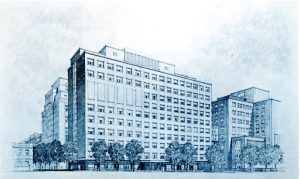
Architect’s drawing of Woman’s Hospital Division
In 1979, St. Luke’s Hospital Center merged with the Roosevelt Hospital forming St. Luke’s-Roosevelt Hospital Center. In 1997, the Hospital Center joined with Beth Israel Medical Center under the Continuum Health Partners banner. In 2013, the Continuum Health Partners merged with Mount Sinai Medical Center forming the Mount Sinai Heath System. The Woman’s Hospital Division on St. Luke’s Hospital campus continued as such for a few years, but eventually duplicated services throughout the combined System. Services re-located, former names were changed, and Woman’s Hospital was consigned to history.
The Woman’s Hospital finding aid is available online here.
Sep 14, 2021
The Mount Sinai Hospital School of Nursing diploma program officially closed 50 years ago in 1971. At that point, it had existed for 90 years and had graduated 4,700 students, including the one and only 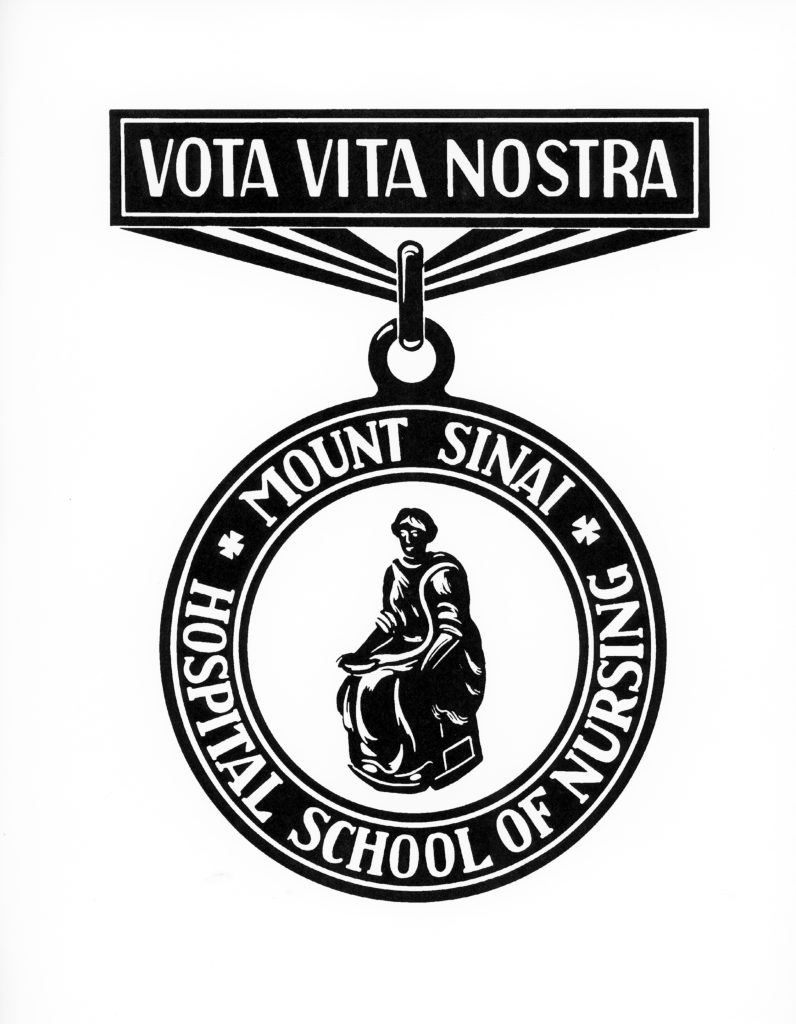 male student in the last class. (A complete history of the School is available here.) Many hospital diploma schools closed during the 1970s, including the St. Luke’s Hospital and the Roosevelt Hospital Schools of Nursing, both in 1974. This wave of closings was due to the schools being fiscal drains on the parent hospitals, as well as the changing educational standards professional nursing organizations championed, including the baccalaureate degree as the best entry-level credential for nurses.
male student in the last class. (A complete history of the School is available here.) Many hospital diploma schools closed during the 1970s, including the St. Luke’s Hospital and the Roosevelt Hospital Schools of Nursing, both in 1974. This wave of closings was due to the schools being fiscal drains on the parent hospitals, as well as the changing educational standards professional nursing organizations championed, including the baccalaureate degree as the best entry-level credential for nurses.
By the mid-1960s, the Mount Sinai Hospital School of Nursing was at a crossroads, trying to find a way to move forward in the face of these trends. In 1967, the newly formed Mount Sinai School of Medicine affiliated with The City University of New York (CUNY). This triggered a review of other possible interactions between the two institutions. That year, the School of Nursing joined with Hunter College, a part of CUNY, to start offering elective humanities credit to the students, easing their path to an eventual baccalaureate degree.
The next twist appeared in the Hospital’s Annual Report for 1968: “This has been a milestone year for the Department of Nursing. Negotiations with the City University led to the joint announcement of a baccalaureate program in nursing to be launched in September 1969 with the [Mount Sinai] Director of Nursing holding the position of Dean of the School of Nursing. Alumnae, staff and students have all expressed enthusiasm at the forward step. They are particularly pleased at the acceptance of the name, The Mount Sinai Hospital School of Nursing at The City College.”
 And so it was, but only briefly. The first class was admitted to the program in fall 1969, along with a sophomore group that had started at Sinai, and a graduation ceremony was held in 1972 for thirteen students. However, the two institutions could not work out long-term arrangements and so the relationship was terminated by 1974.
And so it was, but only briefly. The first class was admitted to the program in fall 1969, along with a sophomore group that had started at Sinai, and a graduation ceremony was held in 1972 for thirteen students. However, the two institutions could not work out long-term arrangements and so the relationship was terminated by 1974.
The closing of the School left behind a saddened but vibrant Alumnae Association that continues to serve its members and The Mount Sinai Hospital today.
Feb 16, 2021
Each January the Aufses Archives starts the New Year by installing a new exhibit highlighting events at Mount Sinai that are reaching a milestone anniversary. In 2021, that includes the celebration of the 175th anniversary of the founding of St. Luke’s Hospital (today’s Mount Sinai Morningside) and the 150th anniversary of the opening of Roosevelt Hospital (today’s Mount Sinai West). The Archives’ staff uses images and original documents to illustrate the most important events, and tries to stick to ‘round number’ anniversaries, e.g. the 25th, 50th, 100th, etc.
Sadly, each year, that leaves us with a group of interesting milestones that are celebrating a ‘not quite a big year.’ Here are a few of those ‘misfit’ milestones for 2021.
1856 – 165 Years Ago
In its first full year of operation, The Jews’ Hospital, later The Mount Sinai Hospital, admitted 216 patients with 129 cured and 14 deaths. Of the 216 admissions, 16 were pay, 200 free. There were two births. The first baby born at the Hospital was called Isaac Touro, in honor of a bequest to the Hospital from him. The patient census varied from a low of 9 to a high of 28. The budget for the year was $5493.76. There were nine paid staff members: two doctors, a Superintendent, nurses, cooks, and domestics.

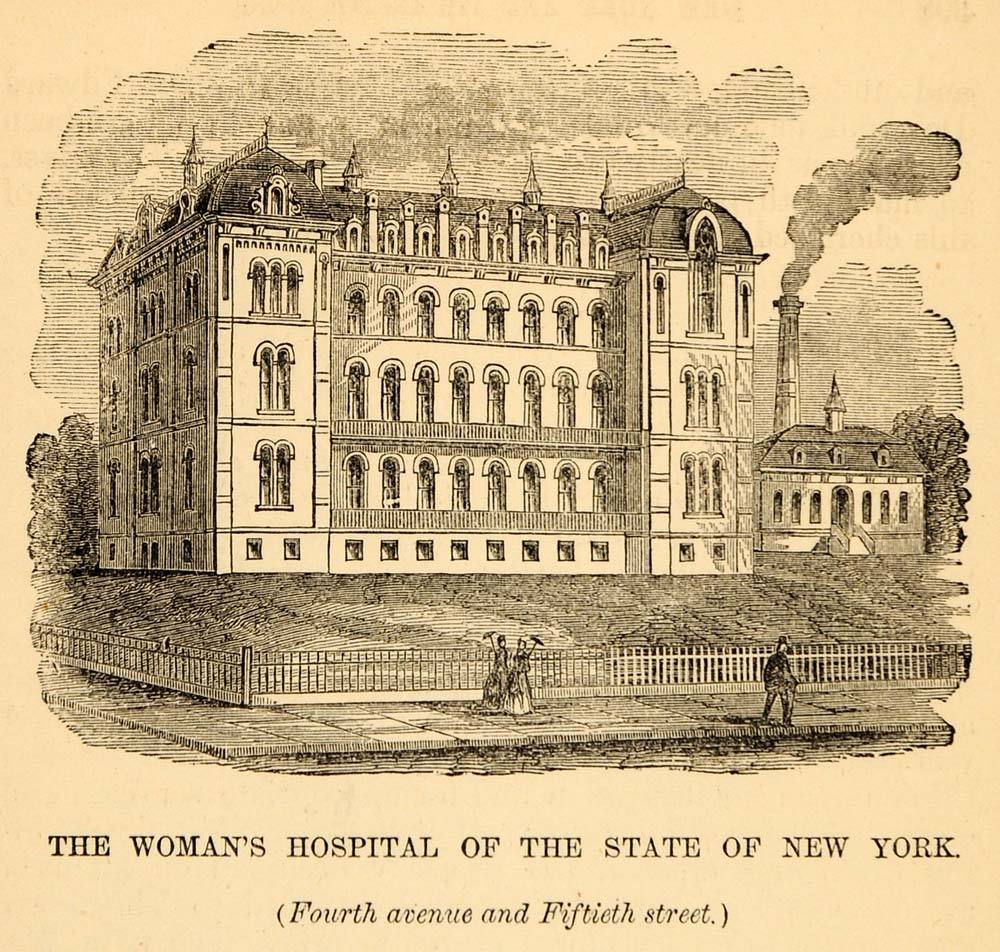
1866 – 155 Years Ago
May 23: the corner stone was laid for a new building between Lexington and Fourth Avenues and 49th and 50th Streets to house the Woman’s Hospital in the State of New York, an institution that would later merge with St. Luke’s Hospital. The City of New York had conveyed the deed to this block to the hospital in 1857. It had been a Potter’s field or Stranger’s Burial Place and filled with coffins. It was noted that more than 35,000 had to be removed before the hospital could be built.
1871 – 155 Years Ago:
On July 12, The Mount Sinai Hospital cared for 25 people injured in the nearby Boyne Day riot, which saw Ulster Scots Protestants holding a parade, protected by NYC Police and State National Guardsmen, with Irish Catholic laborers protesting the celebration. Over 60 people died and more than 150 people were wounded, including 22 militiamen, 20 policemen injured by thrown missiles, and four who were shot, but not fatally.
1881 – 140 Years Ago
William Halsted, MD, organizes an outpatient ‘dispensary’ (Out Patient Dept.) in the basement of the main Admin building at Roosevelt Hospital and remains its director until 1886.
1891 – 120 Years Ago
May 10: Beth Israel Hospital moves to 196 Broadway. This is the first BI location to include inpatient beds in addition to an outpatient dispensary; there are twenty beds. The hospital includes two house staff to provide 24 hour care.
1906 – 115 Years Ago

Beth Israel’s Dazian Pavilion in the 1930s
The Beth Israel Hospital Social Service Dept. is created.
1936 – 85 Years Ago
A Department of Hematology established at the Beth Israel Hospital under the direction of Dr. Louis Greenwald.
1946 – 75 years ago:
The Mount Sinai Hospital opened the first lab in this country dedicated solely to pancreatic disease research; led by Drs. David Dreiling and Henry Janowitz.
1951 – 70 Years Ago
St. Luke’s Hospital Board of Trustees welcomes its first women members: Mrs. F. Huntington Babcock (Dorothy Doubleday Babcock) and Mrs. William Gage Brady, Jr.
1956 – 65 Years Ago
Hugh Fitzpatrick, MD, performs the first open heart repair of a septal defect in New York City at St. Luke’s Hospital.
2001 – 20 Years Ago
The Beth Israel Multimedia Resources Training Center opens. It is a joint project of 1199 SEIU and BI’s Department of Training and Organizational Development to train 1199 members in basic computer skills.










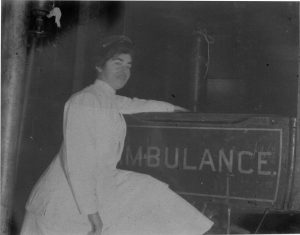
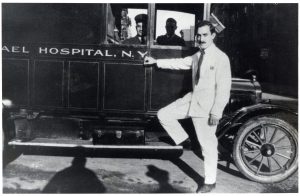

 The Woman’s Hospital, often considered the first hospital in this country dedicated to treating the diseases of women,
The Woman’s Hospital, often considered the first hospital in this country dedicated to treating the diseases of women,  As mentioned above, the first Woman’s Hospital was a rented four-story brownstone at 83 Madison Avenue, off 29th Street, pictured left. The brownstone held forty beds and welcomed its first patient in May of 1855. The response to the Hospital’s opening was so great, by fall of 1855 that another surgeon,
As mentioned above, the first Woman’s Hospital was a rented four-story brownstone at 83 Madison Avenue, off 29th Street, pictured left. The brownstone held forty beds and welcomed its first patient in May of 1855. The response to the Hospital’s opening was so great, by fall of 1855 that another surgeon,  Over the years, the Board recognized the need to develop additional services. A post-graduate school of nursing admitted its first class in 1888. The establishment of a hospital pharmacy in 1881, a maternity ward in 1910, and a social services department in 1912 are examples of the additional services made available at Woman’s Hospital.
Over the years, the Board recognized the need to develop additional services. A post-graduate school of nursing admitted its first class in 1888. The establishment of a hospital pharmacy in 1881, a maternity ward in 1910, and a social services department in 1912 are examples of the additional services made available at Woman’s Hospital. Hospital services resumed in 1906, when a newly constructed Woman’s Hospital opened on West 109th Street, between Amsterdam and Columbus Avenues, pictured left. The hospital functioned here until 1965, when it moved just a few blocks north into a newly constructed building on the
Hospital services resumed in 1906, when a newly constructed Woman’s Hospital opened on West 109th Street, between Amsterdam and Columbus Avenues, pictured left. The hospital functioned here until 1965, when it moved just a few blocks north into a newly constructed building on the 
 male student in the last class. (A complete history of the School is available
male student in the last class. (A complete history of the School is available  And so it was, but only briefly. The first class was admitted to the program in fall 1969, along with a sophomore group that had started at Sinai, and a graduation ceremony was held in 1972 for thirteen students. However, the two institutions could not work out long-term arrangements and so the relationship was terminated by 1974.
And so it was, but only briefly. The first class was admitted to the program in fall 1969, along with a sophomore group that had started at Sinai, and a graduation ceremony was held in 1972 for thirteen students. However, the two institutions could not work out long-term arrangements and so the relationship was terminated by 1974.

